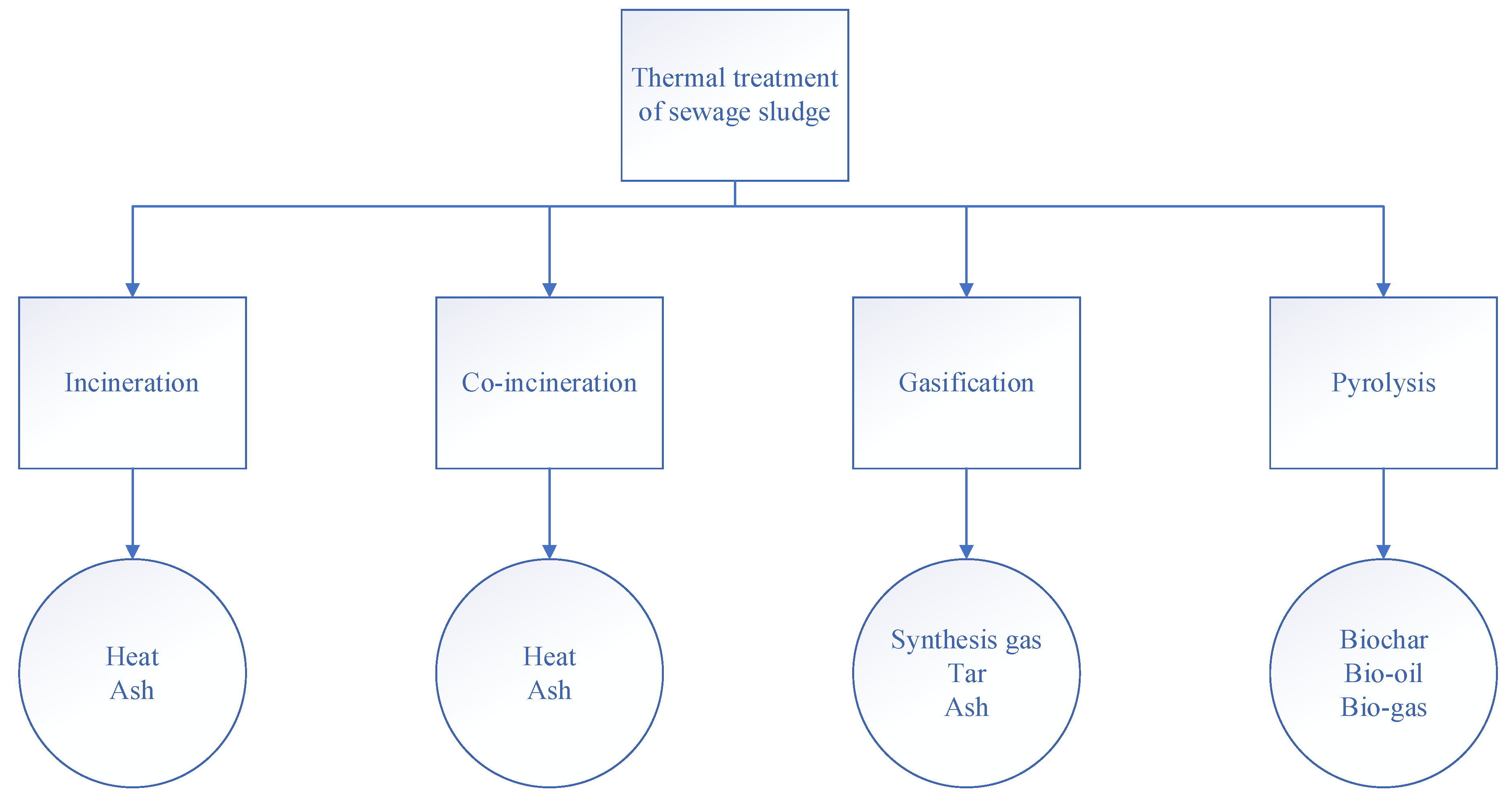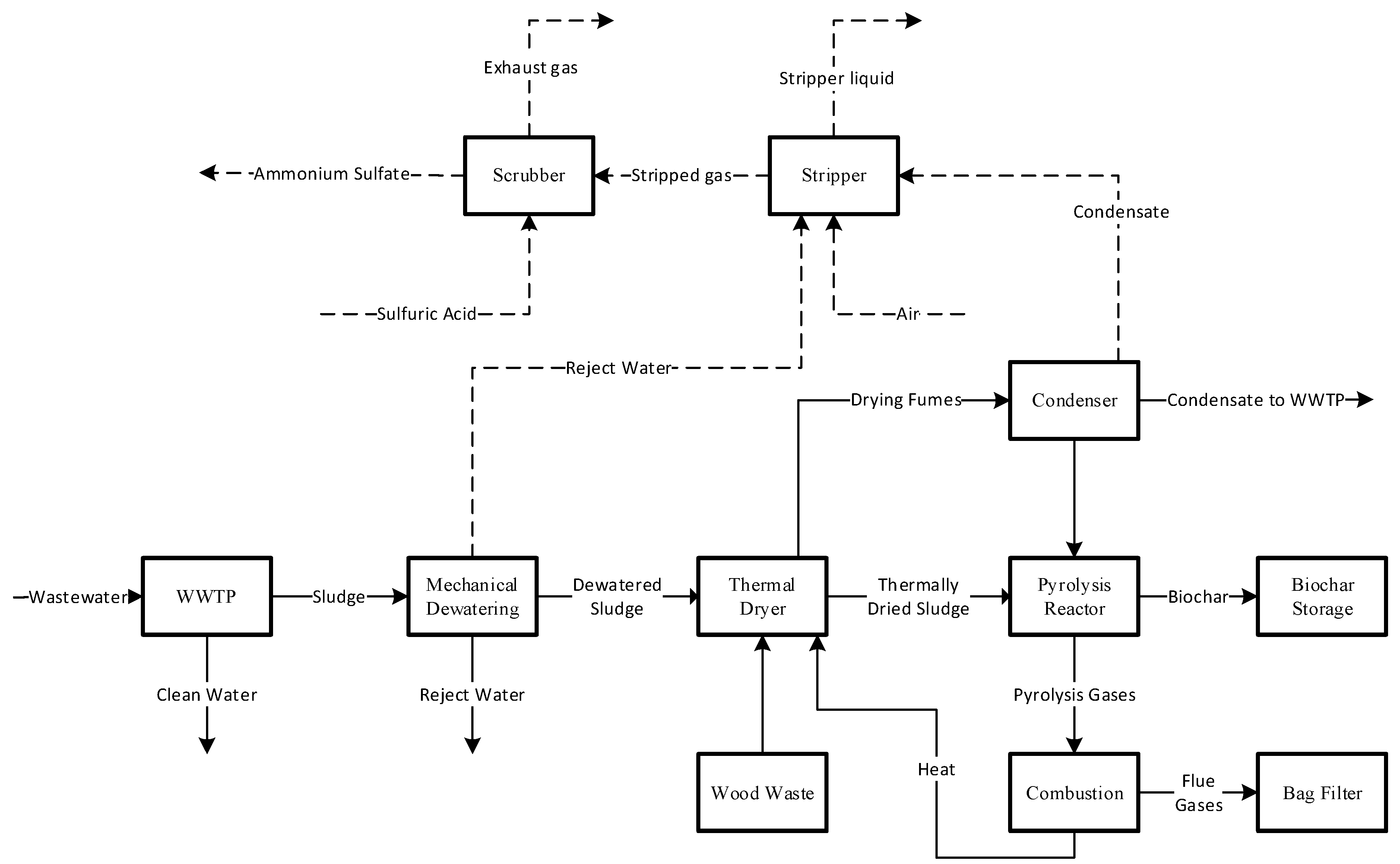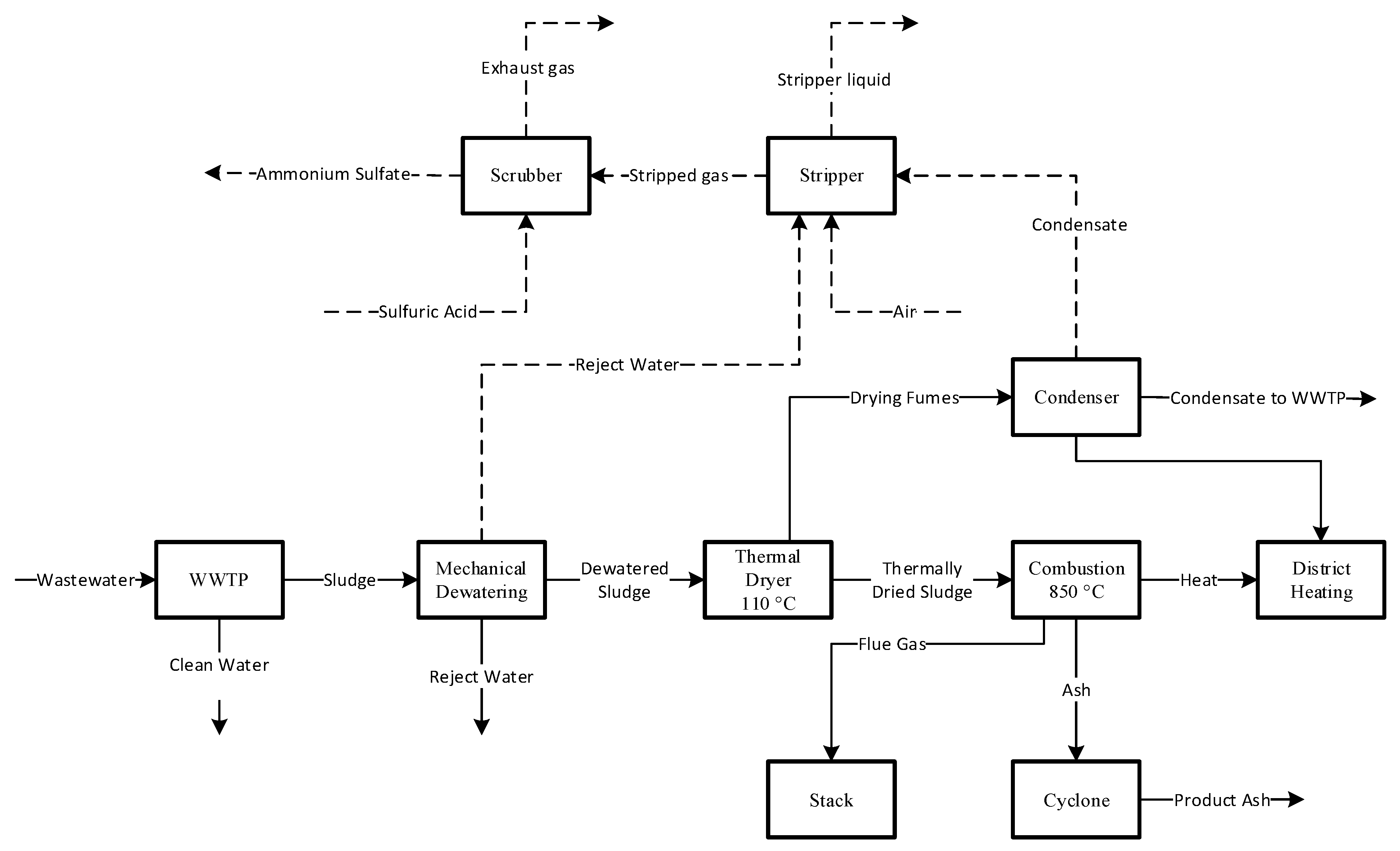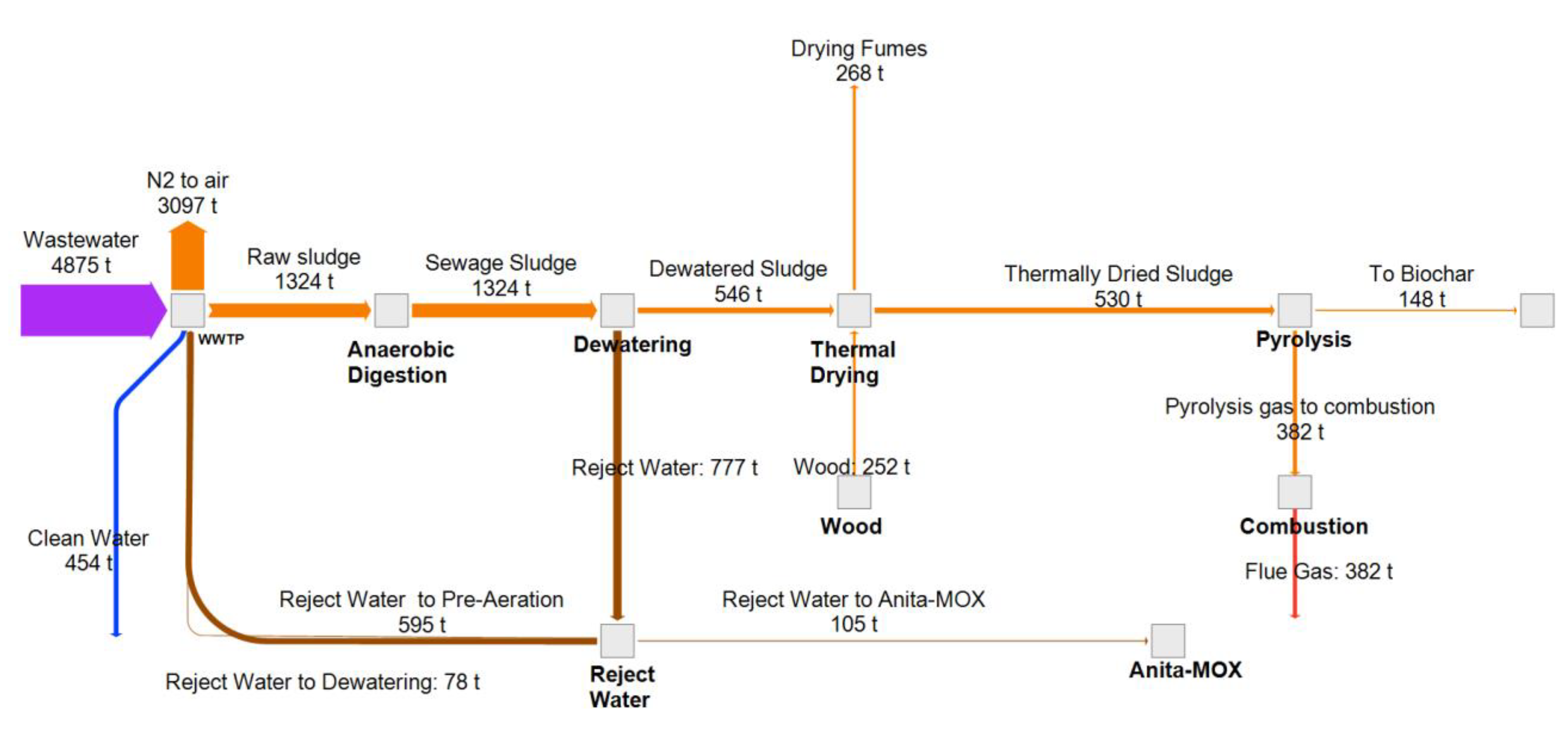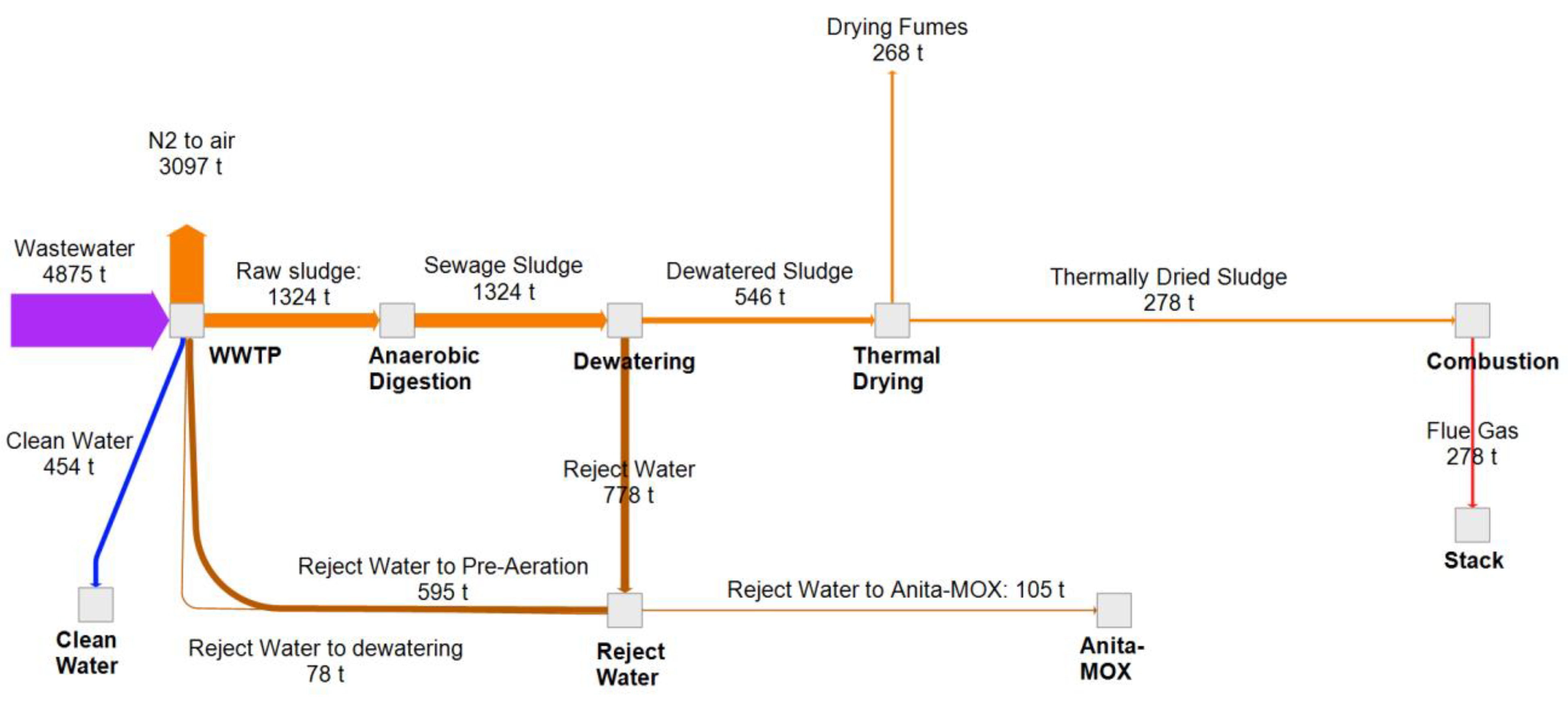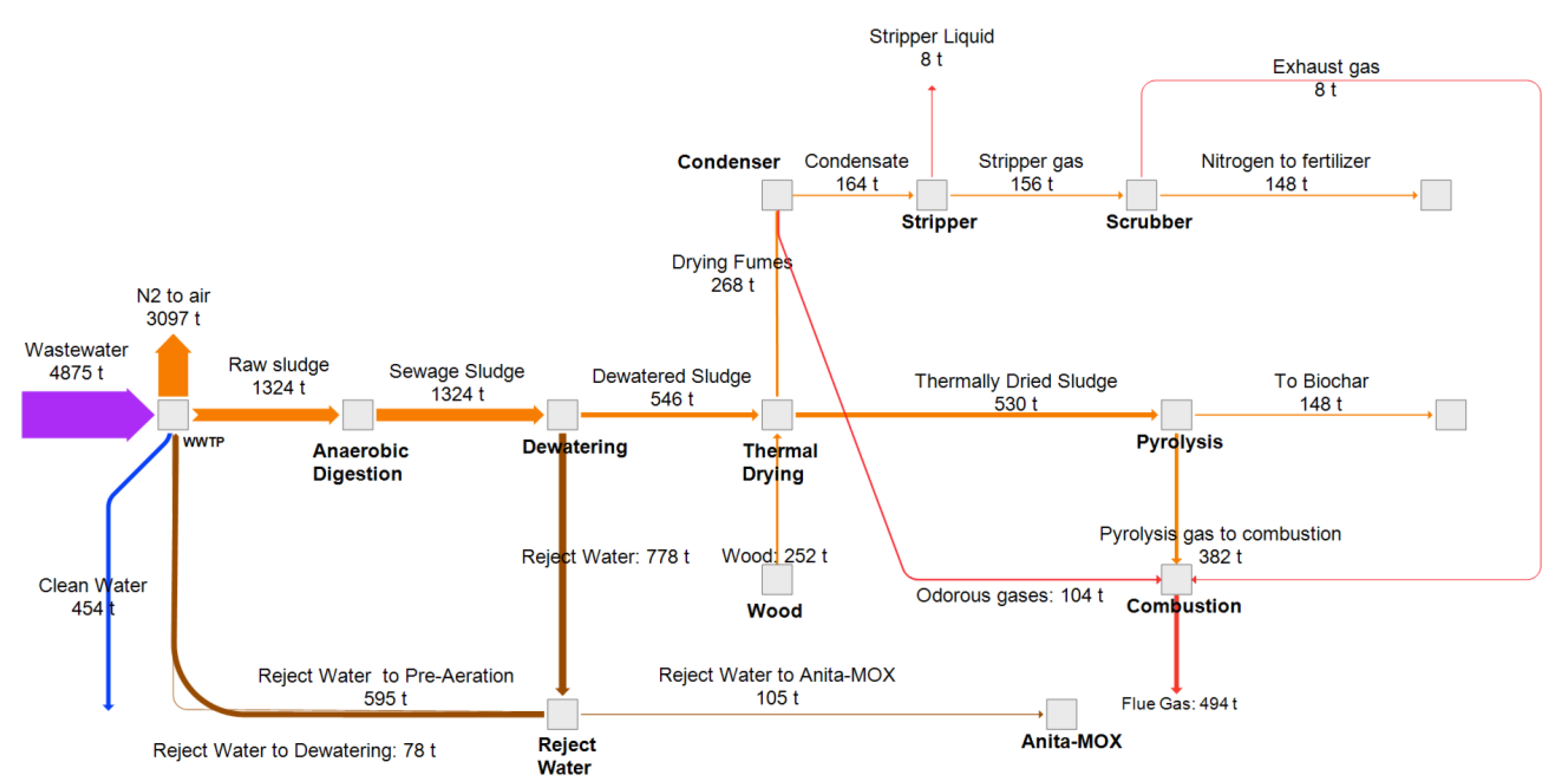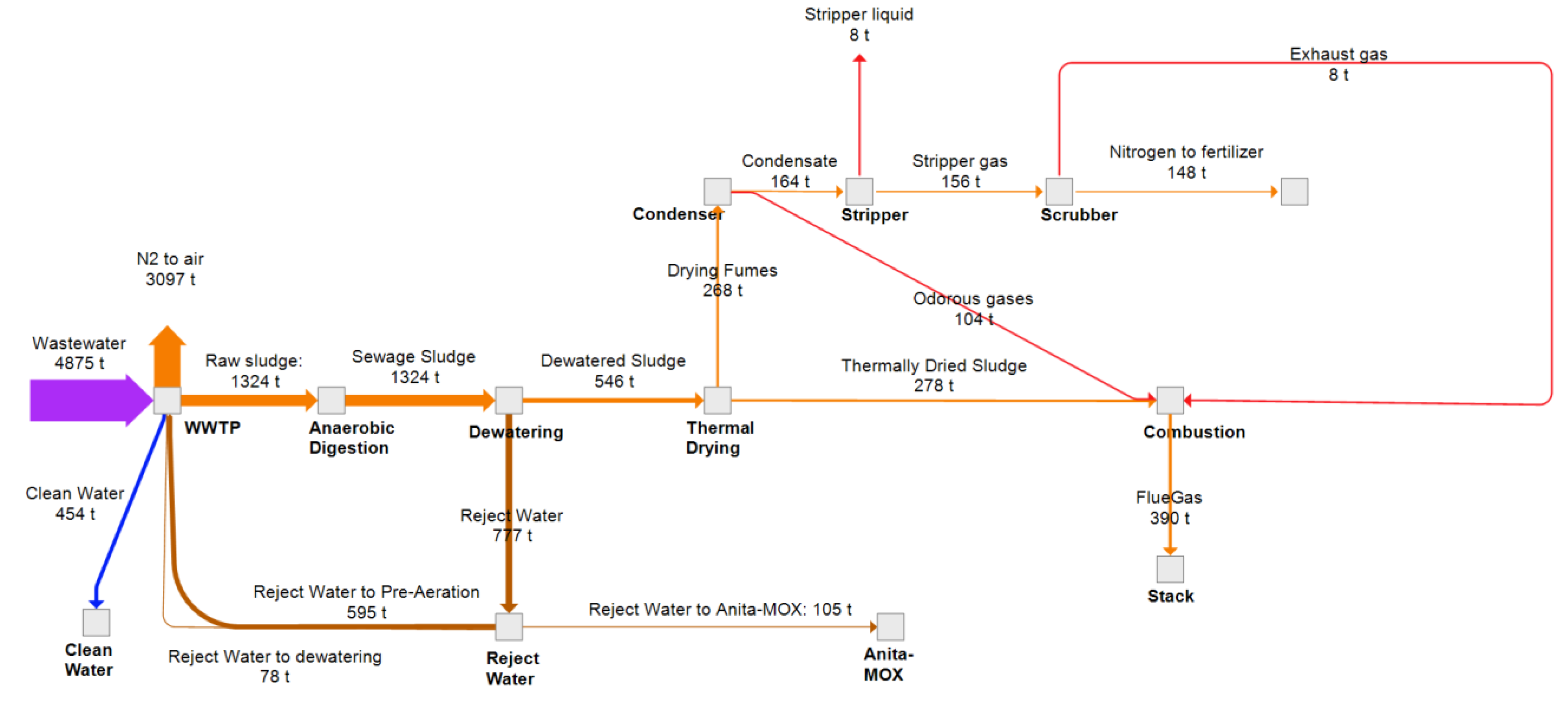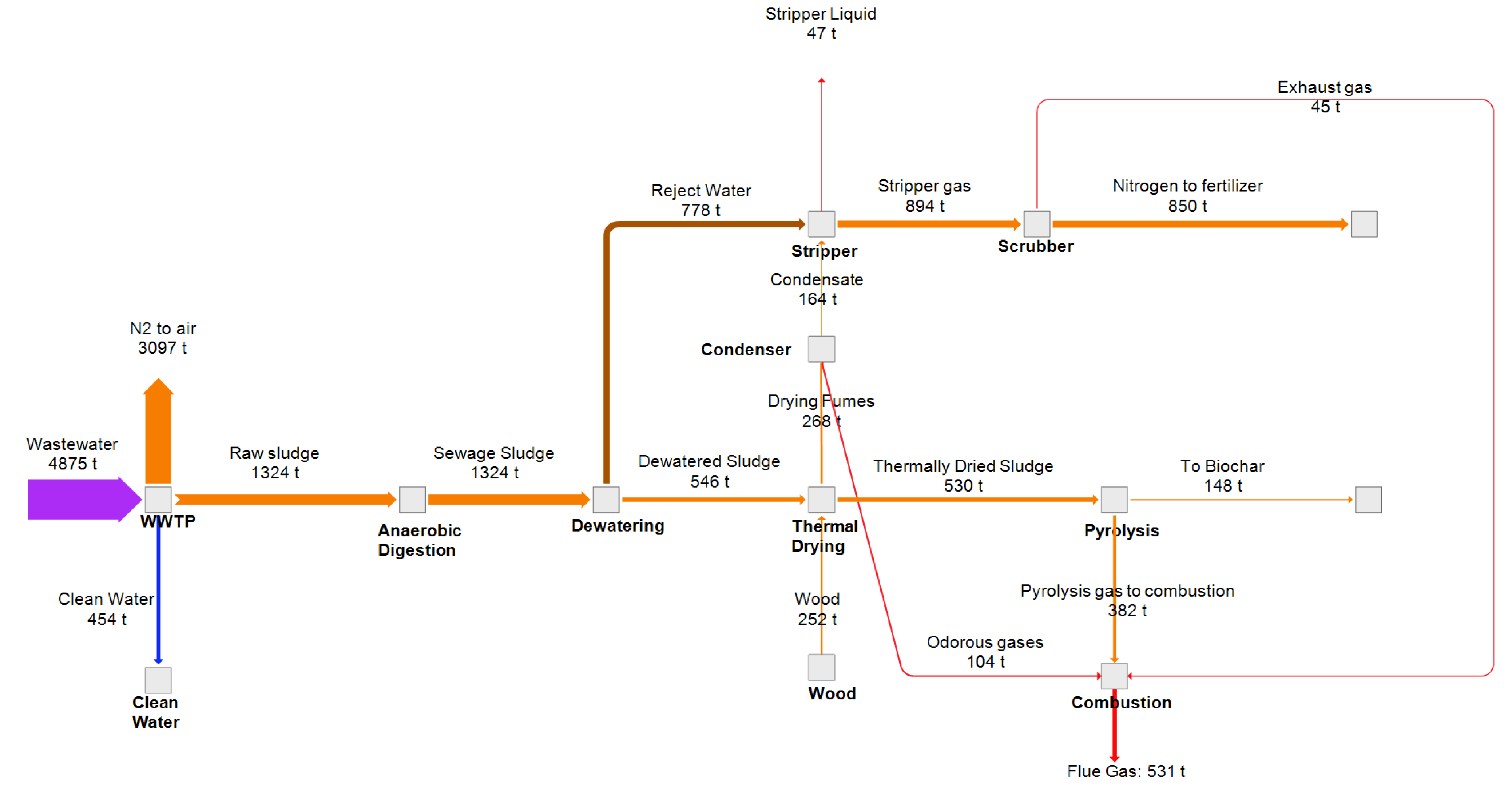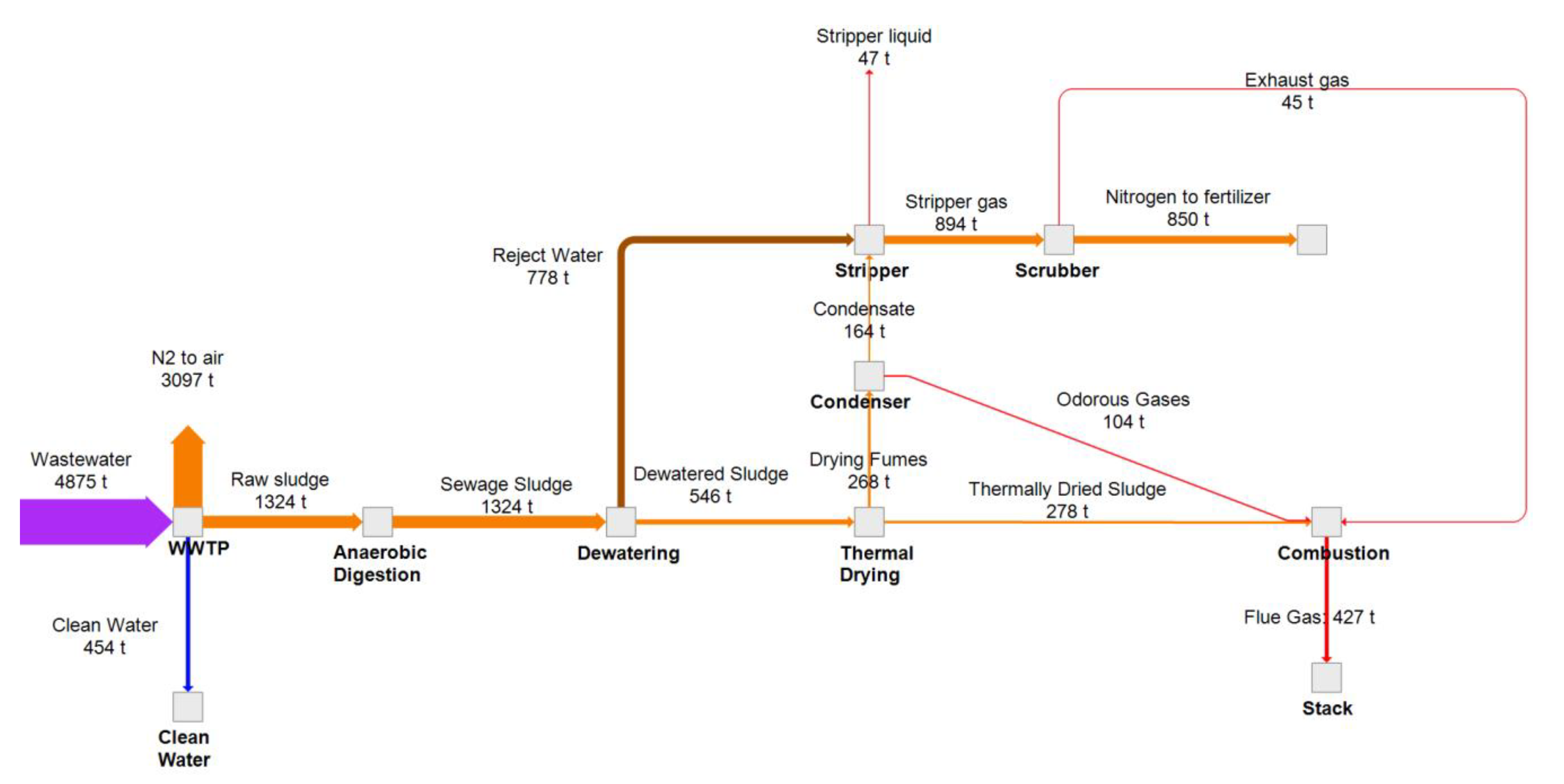1. Introduction
The global population is estimated to increase from 7.7 billion to 9.7 billion by 2050 [
1]. This expected rapid increase, with the concentration of people in cities, raises several problems in terms of waste, particularly sewage sludge, which is the semi-solid byproduct generated during municipal and industrial wastewater treatment [
2]. Billions of tons of sewage sludge and wastewater are produced every year, with the final disposal depending on the country’s policies and regulations [
3]. The current disposal pathways of sewage sludge in the EU include combustion (27%), agricultural fertilizer (42%), landfill (14%), and other applications (17%) [
4].
Sewage sludge contains nutrients such as phosphorous and nitrogen [
5]. However, it also contains harmful substances, including heavy metals, aromatic hydrocarbons, pathogens, and, as was recently discovered, microplastics and medical residues. Due to this fact, sewage sludge utilization as it is, and even after biological treatment, risks soil contamination [
6].
Nutrients, mainly nitrogen and phosphorus, are crucial for the growth of plants and are thus in high demand, specifically as fertilizers [
7]. About 75% of the remaining phosphorus reserves are located in Morocco and, according to one estimate, these will be depleted within 45 to 100 years [
8,
9,
10]. Phosphate, as a critical raw material, has received increased interest in the recovery and treatment of waste, specifically wastewater, to regenerate phosphorus using current technologies.
Nitrogen is a vital nutrient for all living organisms. While nitrogen is readily available in the atmosphere in the form of nitrogen gas (N
2), most plants cannot consume it due to the nonreactivity of molecular nitrogen. Some plants and crops use biological nitrogen fixation to absorb N
2 in the form of ammonium or nitric oxide, but nitrogen fertilizers are needed to increase the crop yield [
11].
The Haber–Bosch process was developed to transform stable N
2 into nitrogen fertilizers to boost crop production [
12]; however, producing 1 ton of ammonia (NH
3) fertilizer consumes about 35–50 MJ/kgN of energy and 950 m
3 of natural gas, while emitting 1.6 tons of carbon dioxide (CO
2). However, only about 17% of the nitrogen produced in this way is ultimately consumed by humans through food sources, and the rest is lost to the environment [
13]. This reactive nitrogen abundantly introduced to the ecosystem represents a significant source of pollution [
14]. Although it has been possible to increase food production through the use of fertilizers, this has led to the disposal of nitrogen in the form of urea and NH
4+ via human defecation, ending up in sewage [
15]. This, in addition to other nitrogen leakages from crop production systems, such as the leaching of nitrogen from fields, causes eutrophication in water bodies [
16].
A wastewater treatment plant (WWTP) is an industrial facility that removes pollutants through a series of operations, including the mechanical, chemical, and biological treatment of incoming wastewater. Wastewater treatment is an energy intensive process in which about 90% of total energy demand is in the form of electric energy. Furthermore, 50–60% of operating costs are taken by sludge treatment whereas electric energy takes a 25–40% share of total operating costs [
4]. Therefore, efficient energy and nutrient recovery from a WWTP can lead to a better efficiency and reduced costs [
17].
Nitrogen is first removed from an aeration tank via nitrification and denitrification, which convert ammonium and nitrate, respectively, into N
2, releasing it into the atmosphere. The remaining nitrogen and phosphorus are bound in the sludge, which advances towards sludge treatment. Anaerobic digesters are one of the most common sludge treatment techniques, whereby the sludge is anaerobically digested to produce biogas, which is utilized in energy generation. The remnants of the process are mechanically dewatered, producing dried sludge and reject water [
18].
The availability of organic matter in wastewater makes it an energy source from the thermodynamic perspective. After wastewater treatment, sewage sludge has an energy content of about 60% in the form of organic carbon, making it a potential energy source [
19]. Moreover, sewage sludge is continuously generated during all stages in a WWTP. Sewage sludge contains organic pollutants, which can undergo thermochemical treatment while reducing the volume and producing energy. Combustion, pyrolysis, and gasification are three main thermochemical treatment methods, with the selection depending on the required temperature range and desired products.
Figure 1 summarizes the thermal treatment options and their products.
In pyrolysis, the organic matter of sewage sludge is thermally degraded at high temperatures in the absence of oxygen. The products are bio-oil, biochar, and syngas. Biochar, which is also produced from biomass such as wood, is used mainly as a fuel, but it can also act as a low-cost adsorbent to remove pollutants in the form of pharmaceutical compounds, heavy metals, organic dyes, and phenolic compounds [
20,
21]. Ammonia inhibition and acid stress in microbes during anerobic digestion are reduced by increasing alkalinity and pH of solution which improves microbial colonization and results in increased yield of methane and digestate quality [
22]. The yield of products depends on temperature, pressure, residence time, heating rate, sludge properties, and particle size. Pyrolysis is further classified in slow, fast, and flash pyrolysis. Slow pyrolysis uses temperatures ranging between 300 and 700 °C and a long residence time at a slow heating rate to maximize the yield of biochar [
23]. In fast pyrolysis, the heating rate is 10–200 °C/s and the residence time is between 0.5 and 10 s to increase the yield of bio-oil. In flash pyrolysis, the heating rate is between 10
3 and 10
4 °C/s and the residence time is less than 0.5 s, with the bio-oil yield slightly higher than in fast pyrolysis [
24].
In combustion, sewage sludge is thermally decomposed at elevated temperatures between 850 and 1300 °C [
25], generating heat and electricity that can be utilized for several operations. Meanwhile, so-called bottom ash is extracted from the bottom of the furnace, and metals can be recovered, while the fly ash escaping with the flue gas can also be captured, e.g., by bag filters or wet scrubbers [
25,
26]. Gasification based on the partial oxidation of the organic solids produces synthesis gas that can be utilized for energy production; however, this process is not further described here as it is not considered as a treatment option.
Thermochemical treatment requires a lower moisture content, but the moisture content of sewage sludge is still 73–84% after mechanical dewatering [
25,
27]. A moisture content too high can decrease the combustion temperature, meaning that the EU Waste Incineration Directive’s minimum required temperature of 850 °C is not met. The high amount of moisture further introduces complexities into the pyrolysis process, such as the formation of high-liquid products and an increase in non-condensable gases [
28,
29]. Thermal drying, usually utilizing heat from the combustion of the sludge or non-condensable (odorous) gases, offers a solution to reduce the sludge moisture content to 5–10%, reducing the complexities and increasing the product quality [
25,
30].
Previous research indicates that nitrogen recovery (instead of simple removal) is difficult to justify economically [
31]. Hence, the efficiency should be improved, and possibilities should be found to at least decrease the costs of nitrogen capture. Single technical solutions, particularly for sludge or wastewater flow, are expensive compared to the yield and value of the utilizable product. Integrating nitrogen capture from more than one stream could improve the total recovery rate and make the investment less costly. For this reason, the current study focuses on the integration of pyrolysis or combustion with nitrogen recovery in the WWTP sludge treatment process to maximize the recovery of nutrients and energy for cases in which biological treatment is insufficient to remove harmful substances from the sludge. It also aims to evaluate the increase in the value and quality of products from sewage sludge by using mass and energy balance calculations and approximating the costs and revenues of each option.
2. Materials and Methods
Two different sludge treatment and recovery processes currently being piloted in Finland, namely pyrolysis and combustion, are selected as the scenarios for analysis in this study. The pyrolysis-based process produces biochar, destined for use as an additive in composting. The other process is based on thermal drying and subsequent combustion of sludge, producing district heat and nutrient-rich (mainly P and Ca) ash, which is used as forest fertilizer. Neither process currently incorporates nitrogen recovery in the pilot plants. In this study, comparability is achieved by using the same sludge input flow for both processes (although the pilot plants and WWTPs have very different sizes).
This study focuses on the following scenarios:
- S1.0:
Pyrolysis without N recovery.
- S1.1:
Pyrolysis with N recovery from thermal drying fumes but not from WWTP reject water.
- S1.2:
Pyrolysis with N recovery from both thermal drying fumes and WWTP reject water.
- S2.0:
Combustion without N recovery.
- S2.1:
Combustion with N recovery from thermal drying fumes but not from WWTP reject water.
- S2.2:
Combustion with N recovery from both thermal drying fumes and WWTP reject water.
Scenarios S1.0 and S2.0 are the base scenarios without the recovery of nitrogen. In the combustion base scenario, part of the fuel energy is recovered and utilized as district heat and the ash product is used as a forest fertilizer. The pyrolysis base scenario uses the sewage digestate in biochar production, and other pyrolysis products are combusted to produce the heat energy required for the thermal drying and pyrolysis process. The pyrolysis process additionally utilizes wood waste (to ensure energy self-sufficiency); in the combustion scenario, this waste is directed towards additional district heat production.
The technical data from the two pilot plants are used in this study. In the pyrolysis scenario, the sewage digestate obtained from the WWTP is pyrolyzed with wood (waste) to produce biochar. In the combustion scenario, the sewage sludge is combusted, and the excess energy is used for district heating. The comparison between the different technologies is enabled by applying the technical performance values for the common sludge mass flow, namely the sludge mass flow of the Viikinmäki WWTP in Helsinki, operated by Helsinki Region Environmental Services (HSY).
2.1. Wastewater Treatment Plant, Sludge Digestion, and Dewatering
In the WWTP plant, wastewater enters with a flow rate of 92 × 106 m3/a with 29 × 106 kg/a total solids (TS). The plant potentiality in terms of population equivalent is 3 m3/day/person. Nitrogen and phosphorus are the two primary nutrients, with mass flow rates of 4900 t/a and 600 t/a, respectively. After the wastewater treatment processes of pre-treatment, screening, and aeration, the raw sludge enters anaerobic digestion, resulting in biogas and digestate. The biogas is used for heat and electricity production, whereas the remaining digestate goes to dewatering. The amount of reject water is calculated based on the difference in the mass of the digestate and dewatered sludge.
The total energy consumption of the WWTP is 0.42 kWh/m
3. After anaerobic digestion, the sewage sludge has a 95% moisture content, and sequential moisture removal processes are key to thermally treating sludge. Thermal drying is an energy-intensive process; therefore, dewatering is performed beforehand to reduce the energy consumption [
25]. Dewatering of the digestate helps to reduce the volume of the sludge by removing water, simplifying transport, and increasing the calorific value [
32]. The pyrolysis of wet digestate generates steam in the reactor, leading to either a higher moisture content in the product or a high production of non-condensable gases. Furthermore, the combustion of high-moisture digestate would not achieve the temperature levels required by waste combustion legislation. Therefore, sewage sludge undergoes mechanical dewatering and thermal drying to reduce the moisture content to 65% and 5%, respectively [
33].
Nutrients, mainly nitrogen, are still available for recovery in the reject water as well as the thermal drying fumes, which are directed to the condenser, with the resulting condensate containing nitrogen. Mass balance calculations are conducted for both dewatering and thermal drying, whereby nitrogen is the key focus in all phases. The nitrogen share in the reject water is about 16% of the total nitrogen contained in the wastewater, which is within the 10–30% range reported in previous studies [
34]. In thermal drying, the target moisture removal is 80% [
30]. Saud et al. [
31] and Deviatkin et al. [
30] investigated nitrogen recovery from thermal drying of sewage sludge using established scrubber technology. The mass balance for the WWTP and the dewatering and thermal drying processes is presented in
Table 1; a more detailed mass balance is given in the
Table S2 of the Supplementary Materialss.
2.2. Pyrolysis Scenario
In the pyrolysis scenario, presented in
Figure 2, wood waste is used together with digestate to produce biochar and pyrolysis gas. The digestate constitutes 70% of the pyrolyzed mass, and the remaining 30% is wood waste. The reason for adding wood waste is to compensate for the lower heating value of the digestate and to introduce more carbon. The pyrolysis process is assumed to be self-sufficient in terms of heat energy through the combustion of the pyrolysis gas and recovering the heat to be used for both thermal drying and pyrolysis. The electricity consumption of the thermal drying process is 0.45 kWh/kg [
36], whereas that of the pyrolysis process is another 0.01 kWh/kg [
35]. The mass balance of the pyrolysis process is summarized in
Table 2.
2.3. Combustion Scenario
The sludge combustion data are taken from a novel sludge combustion plant, sited in Rovaniemi (Finland) and built by Endev Ltd., which has a throughput of 10,000 t/a. After mechanical dewatering in the WWTP, the sludge enters an integrated fluidized bed drying and combustion process (
Figure 3). First, hot sand from a combustion reactor is mixed with the sludge in a dryer to remove moisture, thereby increasing the dry solids content of the sludge to 95–98 wt %. Then, the dried sludge is transferred to a fluidized bed reactor for combustion. The temperature of the reactor is maintained at 850 °C to ensure the destruction of organic pollutants (pathogens, drug residuals, microplastics, etc.). The ash formed in the combustion is carried with flue gases and extracted at two points: the majority of the ash (>95 wt %), the so-called product ash, is collected through a high-temperature cyclone after the air preheater, while the finer ash is removed by a bag filter as byproduct ash. The heat produced in the combustion is used in thermal drying and district heating, whereas the hygienic and nutrient-rich product ash can be used as fertilizer. The water vapor from the fluidized bed dryer is sent to a condenser, and the condensate is directed to the WWTP for wastewater treatment. This condensate contains recoverable nitrogen with concentrations up to 3000 mg/L. The electricity consumption of the combustion plant is 0.147 kWh/t of dewatered sludge, and the thermal efficiency of the plant is 82%.
A wood boiler is also added to the process to make the mass and energy balance comparable with the pyrolysis scenario. The lower heating value (as-received basis) of thermally dried digestate and wood waste is calculated using Equation (1).
where the lower heating value for total solids (LHV
dry,D) is 13 MJ/kg for thermally dried digestate and 18 MJ/kg for wood (LHV
dry,W). Furthermore, the moisture content,
w, is 5% for thermally dried digestate and 41% for wood waste, and the heat of vaporization of water,
l25, is 2.443 MJ/kg. As a result, the lower heating value as received, LHV
ar,D of thermally dried digestate is 12 MJ/kg, and the LHV
ar,W of wood is 9.6 MJ/kg.
2.4. Recovery of Nutrients
In both the pyrolysis and combustion scenarios, 780 t/a of nitrogen ends up in the reject water and can be recovered by adding a stripper and a gas scrubber to the systems. Furthermore, it is assumed, based on Horttanainen et al. [
37], that 12% of the total nitrogen in the dewatered sludge is released in the thermal drying fumes in the form of NH
3. The high moisture content of the drying fumes would result in a diluted fertilizer. To avoid this, a condenser is added to the process before the stripper–scrubber combination, and thus the drying fumes first pass through this condenser; the condensate is directed to the stripper–scrubber combination together with the reject water.
Air is used to separate gaseous ammonia (NH
3) from the liquid in the column in the stripping process. This study assumes a stripping column efficiency of 95% based on the previous literature [
38,
39]. Subsequently, the stripped gas is directed to an acid scrubber to capture ammonia using sulfuric acid to produce ammonium sulfate. In the scrubber, the liquid to gas (L/G) ratio, acid pH, and mass transfer area play significant roles [
31,
40]. The scrubber efficiency is also assumed to be 95% based on previous studies [
41,
42]. The exhaust gas from the scrubber is directed to combustion to destroy possible odorous compounds.
2.5. Cost Estimation
The general cost estimation is conducted based on sewage sludge-derived biochar and district heat prices in Finland.
Table 2 takes only the sewage sludge-derived biochar values into account in the calculation of the total investment cost. However, other wood-derived biochar values are presented to enable a comparison of the prices with sewage sludge-derived biochar. There is a high variation in the district heat prices due to differences in regional transmission and supply and demand. Therefore, an average of all values is considered to calculate the revenue from district heating. All district heating prices are exclusive of value-added taxes (VAT).
Table 2.
Biochar and district heat revenue estimation in the pyrolysis and combustion scenarios.
Table 2.
Biochar and district heat revenue estimation in the pyrolysis and combustion scenarios.
| Biochar (S1.1 and S1.2) | | |
|---|
| Price (EUR/t) | Country | Reference |
| Sewage sludge derived | | |
| 0 | Finland | [43] |
| 400 | Finland | [43] |
| Wood derived | | |
| 700 | Finland | [44] |
| 800 | USA | [45] |
| District heat (S2.1 and S2.2) | | |
| Price (EUR/MWh) | Country | Reference |
| 40 | Finland | [46] |
| 50 | Finland | [47] |
| 60 | Finland | [48] |
| 62 | Finland | [49] |
| 118 | Finland | [46] |
4. Conclusions
The integration of pyrolysis and combustion processes with a gas scrubbing technology at a large-scale WWTP was investigated through mass and energy balance calculations, in order to maximize the recovery of nutrients and energy from municipal sewage sludge. It is shown that approximately 73% (3600 t/a) of the total nitrogen within the wastewater entering the WWTP (4900 t/a) is lost to the air and clean water; the rest is divided between different stages of sludge treatment. Nitrogen can be recovered from two stages: (i) mechanical dewatering (16%, 780 t/a) and (ii) thermal drying (3%, 270 t/a). Furthermore, 120 GWh/a of district heat and 9700 t/a of ash with 500 t/a phosphorus are obtained in the combustion scenario and 12,000 t/a of biochar with 500 t/a phosphorus is obtained in the pyrolysis scenario.
It is not possible to recover a large amount of nitrogen from thermal drying alone, and investment for this purpose only would not be cost-effective. However, there is a likelihood that the ammonia in the off-gases of thermal drying is oxidized, producing NOx emissions, which would make the investment for nitrogen removal/recovery more desirable. The high nitrogen content in reject water can represent a high wastewater treatment cost for sludge treatment plants and a nitrogen load problem for WWTPs. In this regard, it would be beneficial to recover nitrogen from two sources instead of one, i.e., reject water and thermal drying fumes, as it would not substantially change the dimensions of the equipment required for recovery. The recovery from thermal drying fumes could be performed with almost the same effort and expense as the recovery from reject water alone, but the recovery rate would increase by more than 20%.
The addition of a stripper and a scrubber for nitrogen recovery increases the total electricity consumption in both scenarios. Combustion and pyrolysis require annual investment costs of 2–4 M EUR/a and 2–3 M EUR/a, respectively, while 3–5 M EUR/a and 3–3.5 M EUR/a would be generated as product revenues.
Both technologies are viable options for nutrient and energy recovery during sewage sludge disposal, having the capability to overtake conventional sewage sludge disposal methods. However, further research is required for high product yields and decreased investment costs.
